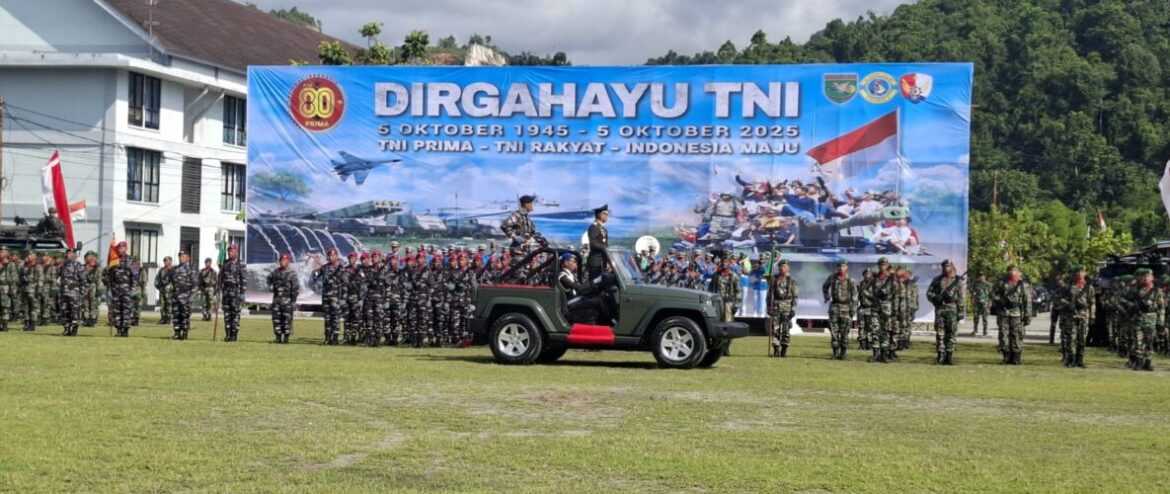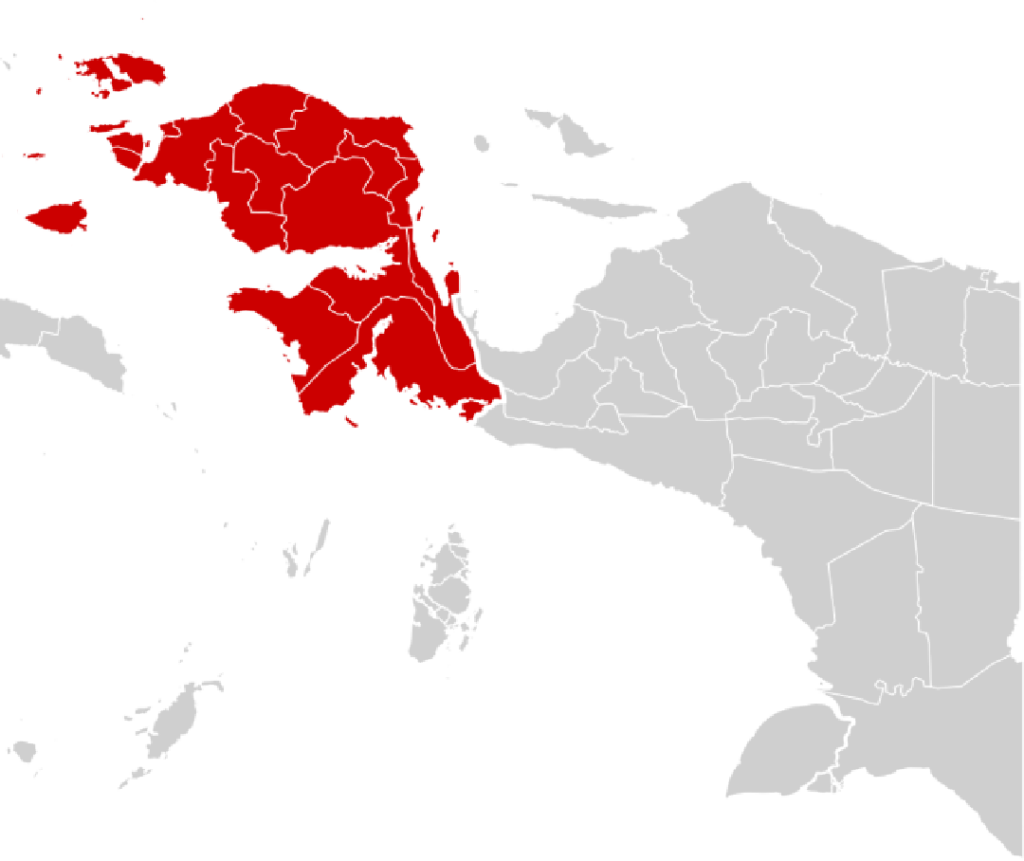At first light on Sunday, October 5, 2025, the skies over Hamadi crackled with anticipation. In the streets, villagers in woven sago-fiber skirts, young men in batik shirts, and schoolchildren waving mini red‑white flags converged toward the Tri Sila/Kodaeral X Field. The spectacle, the 80th Anniversary of the Indonesian National Armed Forces (HUT TNI ke‑80), staged in Papua this year, promised drums, defiles, and Alutsista displays—and above all, a message about belonging, loyalty, and transformation.
The theme resounded: “TNI Prima—TNI Rakyat—Indonesia Maju.”
It expressed not only institutional ambition but a deeper imperative: that the TNI must be seen as “of the people, by the people,” and that in Papua, that means bridging historical distance to allow indigenous Papuans genuine access to the military’s ranks.
A Day of Parade, Pageantry, and Promise
By midmorning, Regional Military Command (Kodam) XVII/Cenderawasih’s parade ground was thronged. The parade counted 1,800 TNI personnel from the Army, Navy, and Air Force—each unit in crisp formation, each uniform spotless, each step measured.
Brigadier General Thevi Zebua, Chief of Staff of Kodam XVII, served as parade inspector, reading out the Panglima TNI’s address.
As the columns passed, mothers hoisted toddlers, elders craned necks, and communities from remote highlands to coastal villages gathered to watch. Local bands played spirited anthems; war cries and rhythmic chanting mingled with the rev of armored vehicles. On the waterfront in Aimas, Sorong, the Marine Corps rolled out amphibious tanks (PT‑76), BTR‑50s, MLRS rocket systems, sea riders, and all-terrain assault vehicles.
Beyond ostentation, the events also included community-service programs, such as market clean-ups, free clinics, and help for vulnerable neighborhoods. In Sentani (Jayapura Regency), for example, TNI and the local government cooperated to distribute staple foods, host bazaars, and engage schoolchildren in “paper plane flights” (as part of broader youth and civic initiatives).
Everywhere, the lighting was not just for spectacle but symbolic: this is Papua’s TNI moment, and the institution intended to show that it belongs—alongside, and not apart from, its people.
Voices in the Crowd: Yearning, Witnessing, and Aspiration
Amid the cheers and the gunmetal glint, dozens of young Papuan faces stood out—some in cadet whites, others in simple shirts, all watching with an undercurrent of quiet urgency. In Jayapura, a youth named Rini whispered to a friend, “If there is space, I will take it. Why should we always watch from the sidelines?”
In Manokwari, a group of the Indigenous Peoples of Papua (Orang Asli Papua, or OAP) youth organizers had gathered earlier that morning near the Kodam grounds. Tala, one of them, leaned ahead and said, “We do not merely ask for token slots. We want pipelines—from high school to tutoring to the academy. We want to shape defense, not just serve it.”
These voices echo what region-wide advocacy bodies like the Majelis Rakyat Papua Barat (MRPB) have been demanding: that affirmative quotas be expanded, institutionalized, and closely monitored. The symbolic moment of a parade is only useful if it flows into real policy.
Affirmative Quotas: The Otsus Lens and Papua’s Promise
When Special Autonomy (Otonomi Khusus, or Otsus) was legislated for Papua, one of its core goals was to uplift Orang Asli Papua (OAP) in public life—education, civil service, and representation in state organs. The inclusion of OAP in TNI and Indonesia’s National Police (Polri) is often invoked as a flagship pillar of that promise.
Yet, in practice, the path has been uneven. Critics have noted that many affirmative policies are partial, temporary, or constrained to certain ranks, and institutional inertia often delays implementation.
Still, recent years have seen tangible gains, especially in Papua and Papua Barat. At Kodam XVIII/Kasuari (Papua Barat), the 2025 Tamtama (privates) recruitment saw a milestone: 49 percent of successful candidates were OAP—263 out of 542.
Even more striking: the total number of OAP admitted to Tamtama/Bintara roles in 2025 soared 930 percent over 2024 figures—leaping from 39 to 402 individuals.
Kodam XVIII leadership attributed that to deliberate prioritization and careful selection.
In Jayapura under Kodam XVII, Bintara (non-commissioned officers) selection also leaned heavily toward OAP: in a recent recruitment, 80 percent of the admitted Bintara cadets were indigenous Papuans.
Local commanders framed that not as a mere quota, but as a correction for structural disadvantage: remote schools, limited preparation, and language gaps that disadvantage Papuan youth in national-level testing.
Even TNI AL has included OAP in its diplomacy missions—such as sending Papuan youth aboard hospital ships to Pacific island nations—to show that Papuan representation is not confined to jungle or highland duties.
Still, gaps persist. Otsus affirmation tends to emphasize non-officer tracks (Tamtama, Bintara) much more than officer schools (Akmil, Akpol). Many Papua leaders worry that the upper echelons remain dominated by nonlocals, undermining full representation. In October 2025, Papua Barat’s Governor Dominggus Mandacan pressed for greater quota access across all branches (Army, Navy, and Air Force) in every new recruitment form. He also promised that provincial and local governments would co-finance initial training costs for OAP recruits, reducing financial barriers.
Mandacan’s appeal came during the HUT TNI event in Manokwari. He argued that providing real opportunity is not just job creation; it is deepening the sense of belonging of Papuans to the institution of national defense.
Across Papua, MRPB and allied institutions have pushed for formal quotas not just in TNI and Polri, but also in civil service, state schools of governance, and leadership positions—especially in the framework of Otsus laws that were meant to guarantee indigenous representation.
Yet challenges loom. Centralized recruitment policies still reside largely in Jakarta. Ensuring that special slots remain not symbolic but binding across recruitment cycles requires legal, bureaucratic, and political adjustments. Questions linger: Will qualification standards be lowered (which could fuel backlash)? Will budget allocations match the ambition?
TNI’s Role: Guardian, Bridge, and Builder of Peace
Papua remains among Indonesia’s most sensitive security environments. In recent months, clashes between TNI units and separatist or armed groups (often grouped under KKB or OPM) have recurred. For example, ahead of the 2025 Independence Day, TNI’s Satgas Operasi Habema engaged in firefights with OPM-affiliated fighters in highland sectors, resulting in casualties.
In this context, TNI’s role is not just defense; it is also confidence-building, community engagement, and cultural diplomacy. By weaving OAP into the ranks, the institution gains legitimacy, roots itself socially, and reduces the psychological distance between state forces and local populations.
Yet such an approach is delicate. Human rights organizations have on occasion raised concerns over excessive militarization, extrajudicial practices, and community trauma.
Critics warn that unless power is checked and civilian oversight strengthened, militarism becomes a default mode rather than a tool.
Still, many Papuans, especially in remote areas, perceive the TNI presence not as an occupation but as a protective shield—an agent against violent itinerant groups, a builder of roads and bridges, and a partner in healthcare missions. Vice President Ma’ruf Amin emphasized that security in Papua must remain a national priority, recognizing that violence still affects civilians.
During the parade in Jayapura, the Panglima’s address (read by Brigjen Zebua) stressed restraint, integrity, and accountability: “Every soldier must avoid acts that harm the people; our duty is defense, not repression.”
In local communities, the presence of Papuan soldiers can smooth tensions, because shared language, customs, and kinship reduce suspicion. A Papuan soldier patrolling his home region may be able to defuse border complaints, mediate disputes, or liaise with clan leaders in ways outsiders cannot. The ideal is not a uniform presence alone, but an embedded force of belonging.
Challenges, Risks, and the Road Ahead
The aspiration of broad and systemic affirmative inclusion faces several critical headwinds:
- Institutional inertia and centralization
Recruitment policies—especially for officer tracks—remain dominated by national headquarters. Local commands can only influence formational slots, but not always control policy levers.
- Balancing merit and opportunity
Skeptics argue quotas may degrade standards. Proponents respond that “merit” often enshrines structural privilege. The balancing act: ensuring fairness without lowering thresholds while investing in preparatory pipelines.
- Sustainability of funding
Expanding quotas means more training, mentorship, stipends, and support systems. Governor Mandacan’s co‑finance pledge is promising, but long-term sustainability depends on stable Otsus funding, central subsidies, and local budget allocations.
- Transparency, accountability, and oversight
Otsus funds have been criticized for mismanagement or corruption. The KPK (Indonesia’s anti‑corruption commission) has repeatedly warned that Papua’s Otsus fund management must be transparent to avoid abuse and ensure actual benefit to communities.
- Political resistance and symbolic gestures
There is a risk that expanded quotas become symbolic gestures—not matched by actual recruitment. Vigilance by MRPB, civil society, and media is essential to translate dialogue into reality.
- Community trust and reconciliation
In areas touched by conflict, the mere presence of armed forces can stir memories of past abuses. Inclusion must come with human rights education, community dialogue, and reconciliatory measures.
Still, the momentum is real. The 80th-anniversary celebrations may have been theatrical, but they also functioned as a political stage—a moment for Papua’s leaders, youth, and the military itself to reaffirm a new social contract.
If the next recruitment cycle yields not just a few OAP names but full platoons, sergeants, and officers from Papuan communities, then the promise of Otsus might move one step closer to reality.
Conclusion
Amid the fanfare of flags and drums, the true story emerging from Papua is not the parade itself but what it aspires to open. The vibrant defile in Jayapura, the flashing amphibious tanks in Aimas, and the presence of TNI units in remote outposts—these are all manifestations of power. But power not channeled toward inclusion risks being hollow.
What matters now is the follow-through: quotas not just in name but in pipeline support; recognition not just of OAP as foot soldiers but as leaders; security not just by martial might but by rooted legitimacy.
Papua’s past has often known division, underrepresentation, and suspicion. The TNI, with its national mandate, now has the opportunity—and the responsibility—to become part of reconciliation, not just enforcement. And the Special Autonomy law, with its call for affirmative inclusion, must become more than a law on paper; it must be lived in barracks, in battalions, and in the hearts of young Papuans who watch parades and wonder, “Is my future here?”
The 80th anniversary is over. The question now—echoing across highlands and mangrove coasts—is will the next generation of Papuan youth see themselves not as spectators, but as leaders in Indonesia’s defense? If affirmative quotas deepen, and TNI becomes an institution of trust and belonging, then Papua may witness not just security but sovereignty of inclusion.


